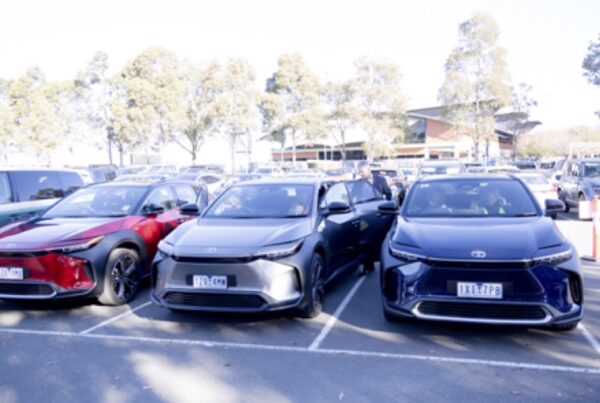Electric Vehicles (EVs) are not just changing transportation; they are also transforming the way we use energy and the infrastructure needed to support this change.
At the recent Victoria Professional Development Forum, Marcus Royle and John Topouzakis from A.G. Coombs Advisory provided expert insights into the challenges and solutions associated with integrating EV chargers in buildings. Here are some important considerations and best practices they highlighted in their presentation.
Electrical Considerations for EV Charging in Buildings
The rapid increase in EV adoption demands efficient and safe charging solutions within various facilities. To successfully install EV chargers in a building, certain electrical considerations must be kept in mind.
First, it is crucial to understand the building’s energy profile. Analysing when, where, and how energy is being consumed within a property can help determine peak demand times. Tools like Energy Management Systems (EMS) can track and manage energy consumption while providing data to optimise EV charger integration.
Second, having a load management system is crucial to avoid exceeding the building’s maximum electrical demand. These systems can dynamically adjust the output of EV chargers based on the building’s real-time energy usage.
Third, it is important to thoroughly understand the capacity and age of the building’s main switchboard. If a building has an older switchboard or if it is nearing its maximum capacity, upgrades may be needed to handle the additional load from EV chargers. Accurate documentation, including single-line diagrams and historical data, helps in effectively planning the integration of EV charging infrastructure in a building.
Fourth, proper installation practices that comply with Australian standards are essential for both safety and efficiency. This includes adequate cable management to avoid damage to charging cables and ensuring that emergency stop buttons are accessible. Safety measures, such as bollards to protect charging stations and clear signage, are necessary to mitigate risks.
Fire Safety Considerations for EV Charging in Buildings
As with any electrical application, fire safety is a critical aspect of charging EV batteries. Lithium-ion batteries can undergo thermal runaway, a condition where a damaged battery cell overheats and ignites, potentially causing a fire. However not withstanding that existing fire safety systems may not be equipped for modern car parks regardless of the type of vehicle being stored, e.g. EV or Internal Combustion Engine (ICE) Vehicle. Understanding the limitations of fire safety systems is crucial for developing effective fire safety strategies, especially for modern car parks.
An example cited during the presentation was the case of the Luton Airport, UK car park fire that destroyed more than 1,500 vehicles. Despite being compliant with UK code/s, the absence of sprinklers led to extensive damage; this event highlights the need for robust fire suppression systems. In addition, it should be noted the fire started from an ICE Vehicle and not an EV.
With modern car parks often containing more plastics and lightweight materials, fire risks are increased. The Australian Building Codes Board is considering updates to improve fire safety in car parks, including mandatory sprinklers for car parks containing more than 40 vehicles. These updates aim to mitigate the risks associated with the evolving nature of car park design and usage.
Investing in fire detection and suppression systems in buildings is crucial for enhancing safety. Modern smoke detectors can now operate effectively in car parks, providing early warnings and helping alert occupants and relevant fire brigade at the early stages of a fire.
Furthermore, building managers must develop and implement comprehensive fire safety plans. This should include regular maintenance, staff training, and coordination with fire safety professionals, which is vital for protecting both the property and occupants.
Practical Recommendations for Building Managers and Owners
Building managers and owners need to ensure that compliance and maintenance measures are implemented on-site. Some practical recommendations for vehicle and building management include:
- Engaging with Registered Engineers and Fire Safety Professionals: These experts can provide valuable guidance on necessary upgrades, compliance with safety standards, and best practices for integrating EV charging stations in buildings. Furthermore, professional assessments ensure that all aspects of electrical and fire safety are thoroughly considered and addressed.
- Planning for Future Needs: Demand for charging stations will only increase as the adoption of EVs continues to grow. By anticipating future EV charging needs, building managers can avoid costly upgrades while ensuring that their infrastructure can accommodate the demand.
- Maintaining Regular Compliance Checks: Ongoing inspections and updates to electrical systems and fire safety measures ensure that a building remains compliant with fire safety standards and is capable of handling increased loads. Proactive maintenance can also prevent potential issues while extending the lifespan of the infrastructure.
Additional Insights from the Q&A Session
The subsequent Q&A session explored several key topics related to EV charging and safety and offered practical advice. Here are the main points that emerged from the discussion:
- EV Charging in Smaller Locations: A fire engineering assessment is crucial even for small installations. The Australian Building Codes Board provides minimum requirements, but a professional review helps improve safety and ensure compliance.
- Differences Between Residential and Commercial Installations: Commercial buildings often have the capacity for three-phase power, which allows for faster charging stations. Meanwhile, residential buildings typically rely on single-phase power, which means slower chargers. The type of charger being installed also determines the complexity and cost.
- Above Ground vs. Underground Car Parks: Safety requirements differ for above-ground and underground car parks. The former can benefit from natural ventilation and smoke dissipation, while the latter requires robust fire protection systems due to their enclosed nature. Regardless of the location, adequate sprinkler systems and fire detection measures are crucial to mitigate the risk of fires.
- EV Fire Incidents in Australia: There are very few EV-related fires in Australia. Research indicates that the likelihood of an EV fire is significantly lower than that of a combustion engine vehicle fire based on current statistics. However, ensuring proper maintenance and repair of EVs is essential to prevent potential issues.
- Impact on Insurance Premiums: Currently, there is no significant increase in premiums for buildings with EV charging stations. In fact, some organisations, like the Red Cross, have negotiated lower premiums despite installing EV chargers across multiple sites. This suggests that insurers are not currently viewing EV charging infrastructure as a major risk factor.
Integrating EV charging stations into buildings requires careful planning, professional expertise, and adherence to safety standards. By understanding the electrical and fire safety considerations, building owners and managers can create safe, efficient, and future-proof infrastructures for EV charging.
As the demand for EVs continues to rise, addressing these considerations will be crucial for ensuring the safety and sustainability of building infrastructures.
AfMA would like to extend a warm thank you to Marcus Royle and John Topouzakis for sharing their expertise.
Did you find this article interesting? Click the ‘heart’ button above to give it a ‘like’!













